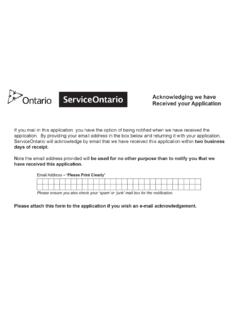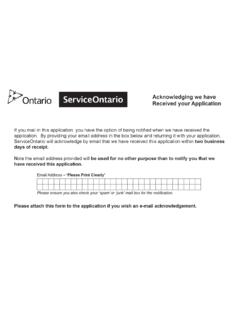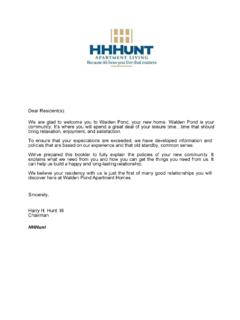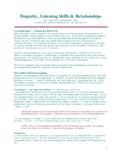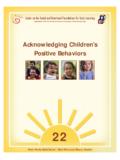Transcription of Publication 1771 (Rev. 3-2016) - irs.gov
1 Charitable Contributions Substantiation and Disclosure RequirementsTax Exempt and Government EntitiesEXEMPT ORGANIZATIONSP ublication 1771 (Rev. 3-2016) Catalog Number 20054Q Department of the Treasury Internal Revenue Service Rules ..2 Written Acknowledgment ..2 Unreimbursed Expenses ..5 Written Disclosure ..6 Further Information ..71 Are you an organization that receives contributions of $250 or more?orAre you an organization that provides goods or services to donors who make contributions of more than $75?orAre you a donor who makes contributions to a charity? IRS Publication 1771, Charitable Contributions Substantiation and Disclosure Requirements, explains the federal tax law for organizations, such as charities and churches, that receive tax-deductible charitable contributions and for taxpayers who make contributions.
2 The IRS imposes recordkeeping and substantiation rules on donors of charitable contributions and disclosure rules on charities that receive certain quid pro quo contributions. Donors must have a bank record or written communication from a charity for any monetary contribution before the donors can claim a charitable contribution on their federal income tax returns. Donors are responsible for obtaining a written acknowledgment from a charity for any single contribution of $250 or more before the donors can claim a charitable contribution on their federal income tax returns. Charitable organizations are required to provide a written disclosure to a donor who receives goods or services in exchange for a single payment in excess of $ on recordkeeping, written acknowledgments and written disclosures is addressed in this Publication .
3 The rules in this Publication do not apply to a donated motor vehicle, boat or airplane if the claimed value exceeds $500. For information on vehicle donations, see IRS Publication 4302, A Charity s Guide to Vehicle Donation, and IRS Publication 4303, A Donor s Guide to Vehicle information about organizations that are qualified to receive charitable contributions, see IRS Publication 526, Charitable Contributions. Publication 526 also describes contributions you can (and cannot) deduct, and it explains deduction limits. For assistance about valuing donated property, see IRS Publication 561, Determining the Value of Donated Proper RulesRequirementA donor cannot claim a tax deduction for any contribution of cash, a check or other monetary gift unless the donor maintains a record of the contribution in the form of either a bank record (such as a cancelled check) or a written communication from the charity (such as a receipt or letter)
4 Showing the name of the charity, the date of the contribution and the amount of the DeductionsFor charitable contributions made by payroll deduction, the donor may use a pledge card prepared by or at the direction of the charitable organization, along with one of the following documents: a pay stub, Form W-2, Wage and Tax Statement, or other employer-furnished document that shows the amount withheld and paid to a charitable a donor makes a single contribution of $250 or more by payroll deduction, the pledge card or other document from the organization must also include a statement to the effect that the organization does not provide goods or services in whole or partial consideration for any contributions made to the organization by payroll payroll deduction amount of $250 or more is treated as a separate contribution for purposes of the $250 threshold requirement for written AcknowledgmentRequirementA donor cannot claim a tax deduction for any single contribution of $250 or more unless the donor obtains a contemporaneous, written acknowledgment of the contribution from the recipient organization.
5 An organization that does not acknowledge a contribution incurs no penalty; but, without a written acknowledgment, the donor cannot claim the tax deduction. Although it s a donor s responsibility to obtain a written acknowledgment, an organization can assist a donor by providing a timely, written statement containing:1. the name of organization2. the amount of cash contribution3. a description (but not the value) of non-cash contribution4. a statement that no goods or services were provided by the organization in return for the contribution, if that was the case5. a description and good faith estimate of the value of goods or services, if any, that an organization provided in return for the contribution36.
6 A statement that goods or services, if any, that an organization provided in return for the contribution consisted entirely of intangible religious benefits (described later in this Publication ), if that was the caseIt isn t necessary to include either the donor s Social Security number or tax identification number on the separate acknowledgment may be provided for each single contribution of $250 or more, or one acknowledgment, such as an annual summary, may be used to substantiate several single contributions of $250 or more. There are no IRS forms for the acknowledgment. Letters, postcards or computer-generated forms with the above information are acceptable.
7 An organization can provide either a paper copy of the acknowledgment to the donor, or an organization can provide the acknowledgment electronically, such as via an email addressed to the donor. A donor shouldn t attach the acknowledgment to his or her individual income tax return, but must retain it to substantiate the contribution. Separate contributions of less than $250 will not be aggregated. An example of this could be weekly offerings to a donor s church of less than $250 even though the donor s annual total contributions are $250 or organizations typically send written acknowledgments to donors no later than January 31 of the year following the donation.
8 For the written acknowledgment to be considered contemporaneous with the contribution, a donor must receive the acknowledgment by the earlier of: the date on which the donor actually files his or her individual federal income tax return for the year of the contribution; or the due date (including extensions) of the and ServicesThe acknowledgment must describe goods or services an organization provides in exchange for a contribution of $250 or more. It must also provide a good faith estimate of the value of the goods or services because a donor must generally reduce the amount of the contribution deduction by the fair market value of the goods and services provided by the organization.
9 Goods or services include cash, property, services, benefits or privileges. However, there are important exceptions:Token Exception Insubstantial goods or services a charitable organization provides in exchange for contributions do not have to be described in the and services are considered to be insubstantial if the payment occurs in the context of a fund-raising campaign in which a charitable organization informs the donor of the amount of the contribution that is a deductible contribution, and:1. the fair market value of the benefits received does not exceed the lesser of 2 percent of the payment or $106,* or2. the payment is at least $53,* the only items provided bear the organization s name or logo (for example, calendars, mug or posters), and the cost of these items is within the limit for low-cost articles, which is $ **The dollar amounts are for 2016.
10 Guideline amounts are adjusted for inflation. See for annual inflation adjustment , unordered low-cost articles are also considered to be of a token exception: If a charitable organization gives a coffee mug bearing its logo that costs the organization $ or less to a donor who contributes $53 or more, the organization may state that no goods or services were provided in return for the $53 contribution. The $53 is fully Benefits Exception An annual membership benefit is also considered to be insubstantial if it is provided in exchange for an annual payment of $75 or less and consists of annual recurring rights or privileges, such as:1. free or discounted admissions to the charitable organization s facilities or events2.










